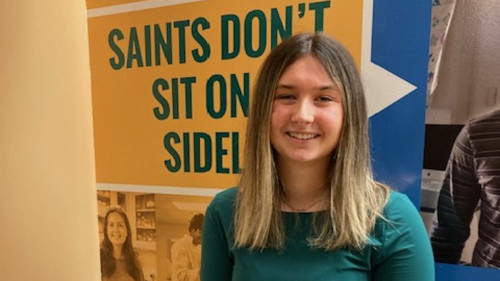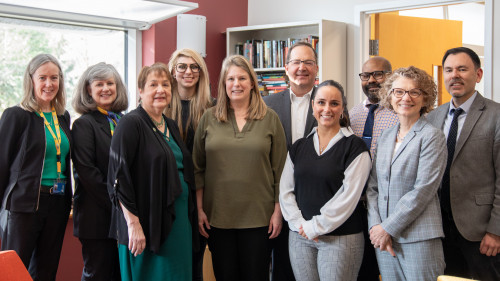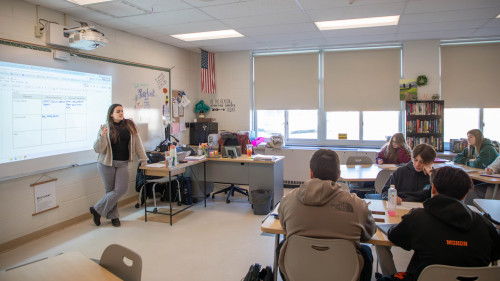
Much in the way that a house or garden tour offers great ideas for enhancing your own living space, Siena hosted its first-ever Open Classroom project for faculty members to observe each other’s teaching methods and get inspiration and ideas.
Christine Dawson, Ph.D., assistant professor of education, and her colleagues on the Committee on Teaching and Faculty Development (COTFD) helped organize the weeklong event.
“This is an informal, low-stakes way for professors to sit in on classes and learn about new teaching strategies,” said Dawson. “We had been discussing new opportunities to get and give feedback, and hosting open classrooms seemed like an excellent option.”
Faculty volunteered to open up their classes and students also were asked to nominate professors whose teaching styles they respected and admired. A schedule of their classes was then created for faculty to sign up and observe their colleagues. Dawson noted that faculty from Siena’s three schools and the library were encouraged to visit classrooms in other schools as well as their own.
Unlike students who are studying to be K-12 teachers, those preparing to teach at the college level may not necessarily study the art of teaching themselves during their graduate and doctoral studies. Many future professors learn to teach primarily by…teaching, which they continue to refine throughout their careers.
Whether it’s methods to encourage student participation or deliver complex new material, or engaging strategies like using YouTube videos or Google Jamboards, this sharing of ideas among all faculty is a collaborative effort that benefits students and professors alike.
“There is a joke that ‘good teaching is theft,’” said Stacey Dearing, Ph.D., teaching assistant professor of English. “Sharing pedagogical methods is an excellent way to serve our students and support each other as faculty.”
Retention of class material is important of course, but Nora Mills Boyd, Ph.D., assistant professor of philosophy, said there is far more to being a good instructor.
“It’s as much about helping students self-actualize and build skills as it is about retaining material,” she said.
Dawson said that in addition to delivery style and engagement, faculty members must also consider how they want to position their students in class.
“We don’t want them to be passive receivers,” she said. “We want them to be active learners, and to feel they are in a transformative environment. We want the students to not just take on knowledge, but to learn how to apply it.”
The planning team members praised Siena’s Information Technology Services team for their assistance with new tech.
“ITS is always incredibly helpful in introducing us to new technology for our classes and helping us use it effectively,” said Sinem Atakan, Ph.D., assistant professor of marketing.
Margaret Madden, Ph.D., provost and senior vice president, said observing other faculty teaching is one of the best ways to learn about different pedagogical techniques.
“Not only does it give faculty new ideas, but it also creates a mentoring community where discussion of teaching methods extends beyond the classroom,” she said. “This initiative was created by faculty for faculty, underscoring how dedicated our professors are to continuously seeking to improve students’ learning experiences.”
Shannon Draucker, Ph.D., assistant professor of English, welcomed the opportunity to visit her colleagues’ classrooms and learn how faculty in other disciplines teach.
“The whole time, I was jotting down the great techniques my friends used so that I could think about how to incorporate them in my own classes,” she said. “I’m so grateful to be part of such an engaged community of teachers and learners.”
Connor Krenzer ’22 nominated John O’Neill, Ph.D., associate professor of business analytics and actuarial science as a great candidate for faculty colleagues to observe.
“There is balance in nature and structure to mathematics, and Dr. O'Neill understands this better than anyone. If you are going to learn math, the best place to start is at the beginning,” said Krenzer. “Dr. O helpfully explains the rationale behind course material – the problems it solves and why the covered topics are important--while keeping the class engaged. With Dr. O, you can be sure to learn how building blocks stack on top of one another while receiving the constant reminder that the world is ours if only we can count! He is, simply, the best.”
Lauren Rock ’22 nominated David Liebschutz, J.D., lecturer in management.
“Dr. Liebschutz is a very interactive and animated professor. The hour and a half class-time always flies by with activities and discussion, it never feels like a lecture,” she said. “We have great discussions in and outside of class, he is interested in getting to know his students and their interests. I am so happy I take his class!”
Lucy Villanueva ’22 nominated the course Early Modern Europe taught by Karen Sonnelitter, Ph.D., professor of history.
“I’m not great with history classes. I tend to lose interest and often find it difficult to engage with the material. Dr. Sonnelitter, however, is incredibly knowledgeable and well-spoken in this discipline and is able to pique my interest with her great storytelling and sharing of meaningful and sometimes funny anecdotes within Europe's early modern history. Instead of rattling off facts or creating her lessons solely off of our readings, she is able to carry out thoughtful and often critical discussions amongst the class in ways that are fun and that matter to us. Because of our discussions, and because she has encouraged us to question and embrace curiosity, I find I am more able to think critically, seeing the whys and hows of certain situations from new angles.”
Drew Califano ’22 said Robert Colesante, Ph.D., professor of education, does an excellent job of incorporating relevant classroom technology into his lessons.
“In my first class with him, one of our activities was to model the ideal school by creating it in Minecraft,” he said. “Dr. Colesante regularly encourages students to take active roles in his classes, using diverse presentational methods as a way for learners to share findings with their classmates. All of these influential teaching methods are aspects of the education field that future professors would be advantaged to observe."
COTFD plans to hold more Open Classroom weeks in the future.

